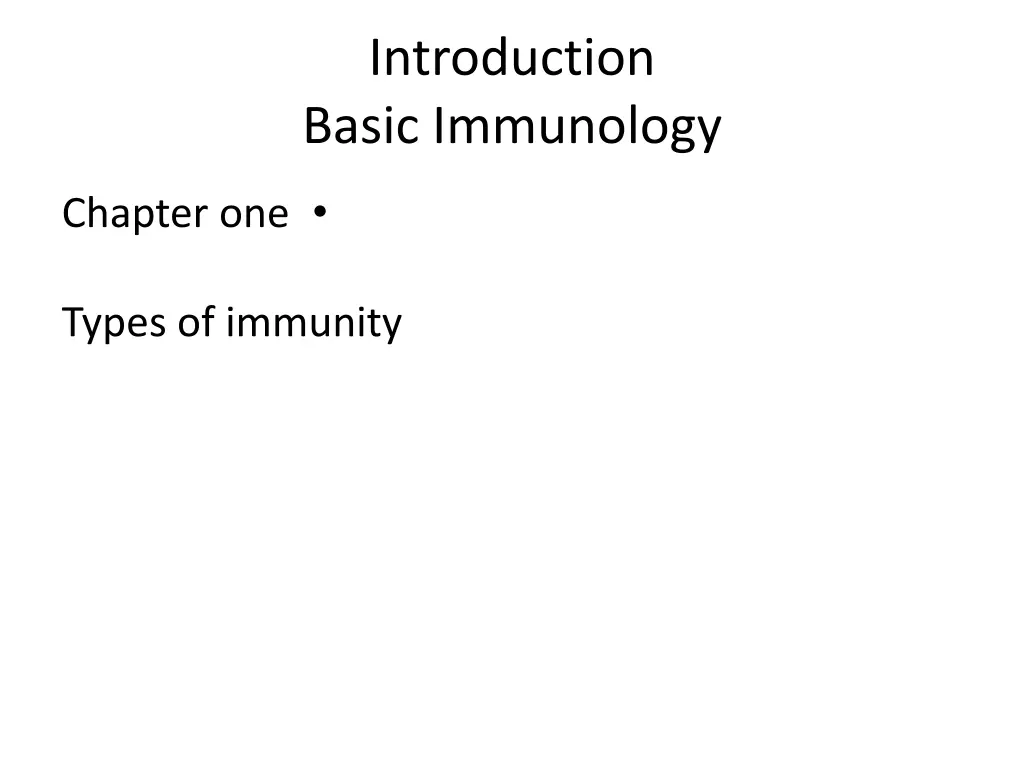
Understanding Types of Immunity in Basic Immunology
Explore the fundamental concepts of immunity in basic immunology, including the definition of immunology, types of immunity (natural and acquired), factors affecting natural immunity, and internal factors like lysozymes and acute phase proteins that play a crucial role in the body's defense system.
Download Presentation

Please find below an Image/Link to download the presentation.
The content on the website is provided AS IS for your information and personal use only. It may not be sold, licensed, or shared on other websites without obtaining consent from the author. If you encounter any issues during the download, it is possible that the publisher has removed the file from their server.
You are allowed to download the files provided on this website for personal or commercial use, subject to the condition that they are used lawfully. All files are the property of their respective owners.
The content on the website is provided AS IS for your information and personal use only. It may not be sold, licensed, or shared on other websites without obtaining consent from the author.
E N D
Presentation Transcript
Introduction Basic Immunology Chapter one Types of immunity
Definition of Immunology The branch of biomedicine concerned with: the study of immunity and the structure and function of the immune s ystem
IMMUNITY Definition of Immunity : It means resistance of the body against foreign body . Foreign body 1.Living body 2.non living body
Type of immunity Natural immunity (innate) Acquired immunity ( adaptive ) Non specific not directed to certain Ag From beginning of life specific From time of exposure to certain Ag Cells T & B lymphocytes . Cells macrophage (M ) Natural killer (NK) Humeral factor ( soluble factor ) Lysozyme _ complement _ cytokine -Acute phase protein Excessive exposure to Ag No memory cell No improve to resistance Antibody Lymphokine There are memory Cell improve resistance
Factors affecting natural immunty 1 - AGE : YOUNG & OLD AGE LOWER NATURAL IMMUNITY BEST IMMUNITY AFTER PUBERTY 2- NUTRITIONAL FACTOR : GOOD DIET CONTAIN ALL VITAMINS & MINERALS PRODUCE GOOD MINERALS IMMUNITY . WHILE DEFICIENCY OF VITAMIN & MINERALS IN AREA OF POVERTY LOW IMMUNITY 3- INFIDEL VARATION 4- RACE VIDUAL VARIATIONS : OR BREED OR SPECIES 5- STRESS (PHYSICAL , EMOTIONAL ) WHERE STRESS STIMULATE ADRENAL GLAND TO SECRETE GLUCOCORTICOIDS . W AFFECT HE IMMUNITY .
6- Hormonal Factors : e.g. cortisone inhibit the immunity Hormonal disturbance Affect immunity . 7- Drugs: e.g. anticancer drugs antibiotic
2ndinterior factor The chemical barrier 1- lysozymes .. A* originated from mucous membrane . B* present in all body fluid except urine and sweat and C.S.F. C* nature : protein . D* function : in all body fluid it contains lysozyme: an enzyme that kill the gram positive bacteria. ~ they cause lyses to the peptidoglycan ( wall of the bacteria or viral envelope).
2- Acute phase protein A* originated from the liver. B* present in blood. C* nature : its group of proteins produce by hepatic cells in low level in healthy body. D* function : in case of infection , macrophage ingest bacteria secrete cytokines activate hepatic cell to secrete large amount of acute phase protein to the circulation (100 times) which bind to CHO of some bacteria e.g. pneumococci. Acute phase protein has opsonic effect . E* psonization : coating of m.o and make it palatable to phagocytosis. APP activate complement cascade which cause lysis to m.o. * *Diagnosis of bacterial disease: accompanied with high level of APP(CRP).
3- complement.. A*originated from liver and M (some factor). B*present in serum. C*nature : 21 protein molecules. D*present in circulative in an in active form and activated during infection cascade activation ( in serial). E* function : lysis of the Ag-Ab immune complex. 4-cytokines.. A*nature : protein in nature. B*originated interleukin 1 and IL.6 from macrophage during infection. C*function: they go to the hypothalamus which contain the center of body temperature (heat regulatory center) for induction of fever ( unfavorable to the m.o).
*they go to the liver to increase the production of acute phase protein. *they go to the bone marrow to produce neutrophile neutrophilia . and also go to the T and B lymphocytes to increase the immune response
5-interferons.. They are protein molecules. A*Gama interferon's : - interferon's. *origination: from any infected body cell. Againt any m.o especially virus. *function: has antiviral effect and called immune IF. Activate m , .NK , IL-1 & TL2 & antibody production. B* beta IF from b-lymphocytes and called. C*alpha IF from leukocytes and called leukocyte .IF
Interferon Antibody -24 72 hour -after 14 days from infection - from all cells -Non specific -Still for 24- 72 hour from infection - from B lymphocytes - specific - still a long time
The cellular barrier (2ndline of defence)
1- phagocytes a- Macrophage -Big -Eater Most largest blood cell. * Promonocytes are produced in the bone marrow Then, become Monocytes in the blood Then, converted into macrophage in tissue (maturation) of monocyte to macrophage *
2- Fixed macrophage In epidermis called langerhans cell * * In lung called alveolar macrophage. * In centrol Nervous system called microglia * Liver called k pffer s cell. * Bone called osteoplast
3- Wandering m. monocytes. * It is long liver, depend on mitochondria for energy & are best in attacking dead cells & pathogens. * Play rale in natural & acquired immunity Function: phagocytosis & secretory function
